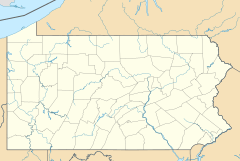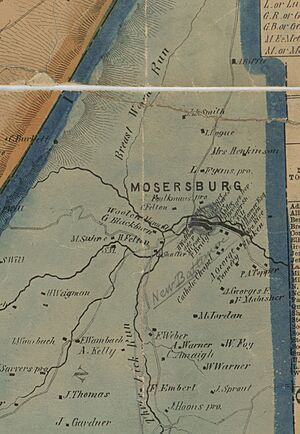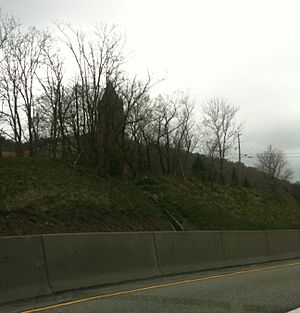New Baltimore, Pennsylvania facts for kids
Quick facts for kids
New Baltimore, Pennsylvania
|
|
|---|---|
|
Borough
|
|
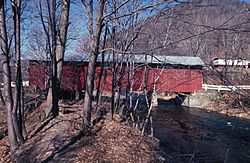
New Baltimore Covered Bridge
|
|
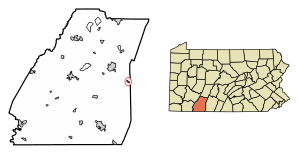
Location of New Baltimore in Somerset County, Pennsylvania.
|
|
| Country | United States |
| State | Pennsylvania |
| County | Somerset |
| Settled | 1829 |
| Incorporated | 1874 |
| Government | |
| • Type | Borough Council |
| Area | |
| • Total | 0.35 sq mi (0.90 km2) |
| • Land | 0.35 sq mi (0.90 km2) |
| • Water | 0.00 sq mi (0.00 km2) |
| Population
(2020)
|
|
| • Total | 142 |
| • Density | 409.22/sq mi (158.16/km2) |
| Time zone | UTC-5 (Eastern (EST)) |
| • Summer (DST) | UTC-4 (EDT) |
| ZIP code |
15553
|
| Area code(s) | 814 |
| FIPS code | 42-53168 |
New Baltimore is a small town, also known as a borough, in Somerset County, Pennsylvania, United States. In 2020, about 137 people lived there. It is part of the larger Johnstown, Pennsylvania, metropolitan area.
Contents
History of New Baltimore
The first person to settle in this area was Michael Riddlemoser. He built a house here in 1820. Later, in 1829, he planned out the streets for a new community.
This community was first called Mosersburg, named after Michael Riddlemoser. It was later renamed New Baltimore. This new name came from Riddlemoser's hometown. New Baltimore officially became a borough in 1874.
In the 1880s, there were big plans for New Baltimore. A large railroad yard and repair center were supposed to be built here. This was for the South Pennsylvania Railroad. However, the railroad project stopped, and the tracks were never built. Because of this, New Baltimore did not become a major railroad hub.
The New Baltimore Bridge is an important part of the town's history. It was built in 1879. In 1980, this bridge was added to the National Register of Historic Places. This means it is a special place worth protecting.
Geography and Location
New Baltimore is located at 39°59′2″N 78°46′20″W / 39.98389°N 78.77222°W. It sits on the eastern edge of Allegheny Township. It is also right next to the border of Bedford County.
The United States Census Bureau says that New Baltimore covers about 0.3 square miles (0.9 square kilometers). All of this area is land. The town and nearby mountains have many farmlands. Most of the area to the west is covered by forests.
Population and People
| Historical population | |||
|---|---|---|---|
| Census | Pop. | %± | |
| 1880 | 150 | — | |
| 1890 | 185 | 23.3% | |
| 1900 | 201 | 8.6% | |
| 1910 | 177 | −11.9% | |
| 1920 | 174 | −1.7% | |
| 1930 | 137 | −21.3% | |
| 1940 | 260 | 89.8% | |
| 1950 | 221 | −15.0% | |
| 1960 | 263 | 19.0% | |
| 1970 | 214 | −18.6% | |
| 1980 | 221 | 3.3% | |
| 1990 | 162 | −26.7% | |
| 2000 | 168 | 3.7% | |
| 2010 | 180 | 7.1% | |
| 2020 | 137 | −23.9% | |
| 2021 (est.) | 136 | −24.4% | |
| Sources: | |||
In the year 2000, there were 168 people living in New Baltimore. The population density was about 531 people per square mile. There were 66 households in the borough.
The people living in New Baltimore were of different ages. About 22.6% of the population was under 18 years old. About 17.3% of the people were 65 years old or older. The average age of people in New Baltimore was 39 years.
Education
Students in New Baltimore attend schools in the Berlin Brothersvalley School District.
Transportation and the Church of the Turnpike
New Baltimore is located just north of the Pennsylvania Turnpike. This major highway includes Interstates 70 and 76. However, there is no direct exit from the Turnpike into New Baltimore. You can also reach the town using U.S. 30, which is also known as the Lincoln Highway.
St. John the Baptist Church
New Baltimore is famous for the St. John the Baptist Church. This Carmelite church is on the southern side of town. What makes it special is that it used to have two sets of steps leading directly from the Pennsylvania Turnpike. One set of steps was on each side of the highway. The church itself is on the eastbound side of the Turnpike.
These steps were built when the Turnpike first opened. The church and the Pennsylvania Turnpike Commission (PTC) had an agreement. The Turnpike had separated the church from the rest of New Baltimore. Also, some Carmelite priests were buried where the Turnpike was built. Their graves had to be moved. For a long time, these steps were a unique sight for travelers. People would even stop on the Turnpike to visit the church.
In 2007, the PTC announced that the steps would be removed. This was because the Turnpike was going to be widened. Even if there was a written agreement, new safety rules meant the steps could not be replaced. Demolition work on the steps began in November 2022. The removal of the steps was completed by August 2023.
See also
 In Spanish: New Baltimore (Pensilvania) para niños
In Spanish: New Baltimore (Pensilvania) para niños


